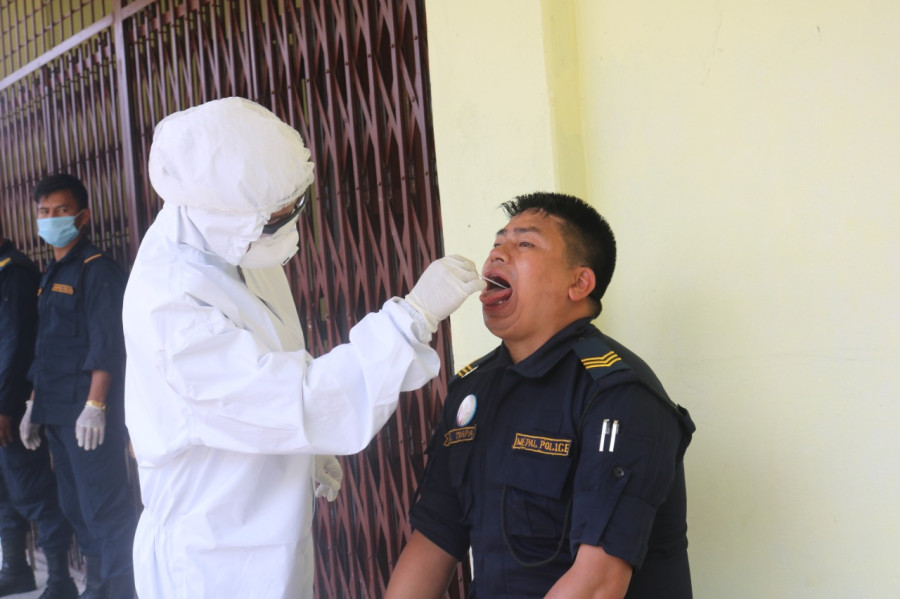National
Health workers deployed at Covid-19 front line deprived of risk allowance in Syangja
Most local units have not disbursed risk allowance to its health workers while some haven’t even paid their full salary.
Pratiksha Kafle
Hum Bahadur Rana has been working in the frontline as a lab technician in Kaligandaki Rural Municipality, Syangja, since the start of the Covid-19 pandemic. As per an announcement made by the Ministry of Health and Population, health workers deployed in the frontline are to get a risk allowance equivalent to their salary. However, he has not received any allowance so far.
“I have been hearing about health workers getting allowances from the start of the pandemic. But I haven't received it until now,” said Rana. “How many times should I ask for the allowance?”
Rana is an auxiliary health worker by profession. But since the start of the Covid-19 pandemic, he has been working as a lab technician.
“I am collecting swab samples of suspected individuals in quarantine and isolation facilities. I am the only one deployed here to do the job,” Rana said.
Kaligandaki Rural Municipality had appointed Rana at Rs 18,000 salary per month on a contract basis.
“I don’t even know how much money I’m due to get as risk allowance,” said Rana.
The Ministry of Health and Population had committed to providing a risk allowance equivalent to the salary of health workers—doctors, nurses and lab technicians—involved in the sample collection, testing and treatment of Covid-19 patients. Other staff deployed in contact tracing and caring of Covid-19 patients were also supposed to get 50 percent of their salary as risk allowance.
Syangja is ranked a high-risk district in Gandaki Province in terms of total cases of Covid-19. A total of 338 people have been infected with the virus in the district so far. But the majority of the local units in Syangja have not provided risk allowance to health workers. Only a couple of local units have been providing allowances to some health workers.
Likewise, health workers in Bhirkot Municipality have also not received any risk allowances. Kashmira Khanal, a lab technician in the municipality, said, “I have only received Rs 20,000 in total since the start of the pandemic. I have asked the municipality for a risk allowance but have yet to receive any.”
Nokamaya Gurung, a lab technician in Biruwa Rural Municipality, also says that he too hasn’t received any risk allowance.
“I have been working for a monthly salary of Rs 12,000. I have yet to receive the salary of almost three months, let alone get a risk allowance,” said Gurung. “I would be happy if the municipality just gave me my full salary on time.”
Health workers in Andhikhola Rural Municipality also complained that they have been deprived of risk allowance.
Yam Prasad Sharma, chief at District Health Office in Syangja, said, “Every health worker by now should have received Rs 100,000 as risk allowance taking into account that we are almost six months into the pandemic. But not all local units are providing the allowance to health workers. Our office has directed all local units to give risk allowance to health workers.”
According to Sharma, there is a discrepancy in the salary of health workers across the district.
“Some of the local units are paying health workers a monthly salary of Rs 24,000 to Rs 26,000 and also providing allowances. But other local units haven’t even been paying their health workers monthly salaries on time,” he said.
Khim Thapa, chairman of Kaligandaki Rural Municipality, said the health workers haven’t received their risk allowance because of a “technicality issue”.
“Our local unit started releasing risk allowance to the health workers before any other local units in the district,” he said. “But in order to receive the allowance, the health workers have to open an account in the District Treasury Controller Office and most of the health workers haven’t done that.”
Meanwhile, Chhayaram Khanal, mayor at Bhirkot Municipality, claimed that his municipality has been providing allowances equivalent to 50 to 100 percent of their salaries to health workers.




 19.12°C Kathmandu
19.12°C Kathmandu.jpg)















